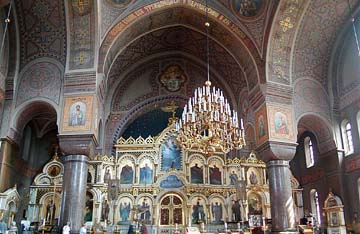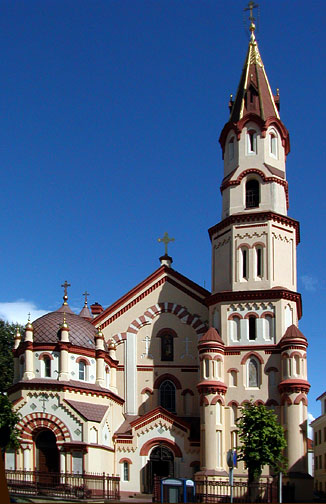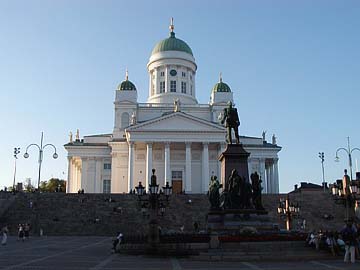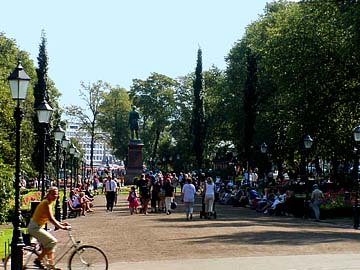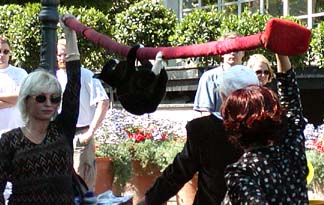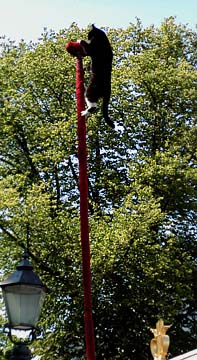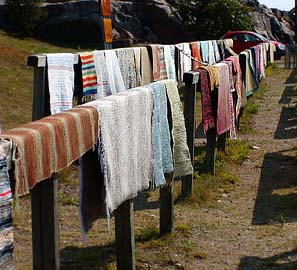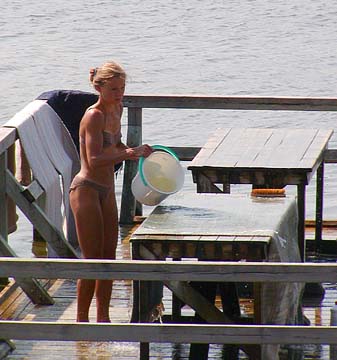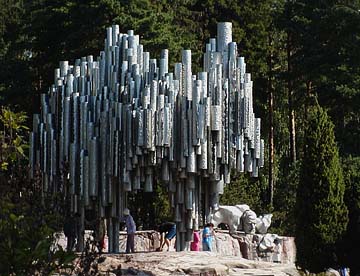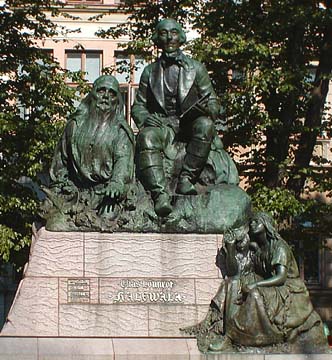 |
|||||||||||||||||||||||||
|
With Finland’s independence in 1917, Helsinki became the capital of the new republic. The growth of the city continued during the early decades of the century. Helsinki was scheduled to host the 1940 Olympics and built a huge new stadium for the event. However, it was canceled due to WWII and Helsinki had to wait until 1952 to host the second postwar Olympics
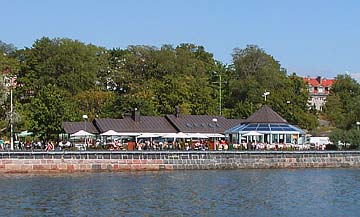 For lunch, we stopped a the Cafe Ursula, left, which sits on the edge of the Baltic Sea. The view is out to the islands to the south of the city, where the Suomenlinna Fortress sits (picture at top of page).While at lunch, we were treated to a show by the local bungee-jumping enterprise along the shore. Jim said he would jump right after Verna completed her jump. We decided to watch instead. For lunch, we stopped a the Cafe Ursula, left, which sits on the edge of the Baltic Sea. The view is out to the islands to the south of the city, where the Suomenlinna Fortress sits (picture at top of page).While at lunch, we were treated to a show by the local bungee-jumping enterprise along the shore. Jim said he would jump right after Verna completed her jump. We decided to watch instead.
Also on the waterfront in this area are platforms built solely for the purpose of washing your rugs (below right). Evidently this is an annual custom and appears to be very popular with the locals, judging from the number of rugs hanging out to dry (below left). Verna stopped to watch them for a while and found that they are washing them with salt water fresh from the Baltic Sea. We were assured that only gentle, biodegradable soaps were used. Also provided are large roller wringers for getting the water out efficiently. So Jim, got any rugs that need washing???
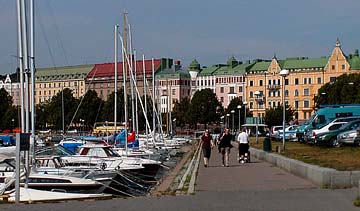 This area of the city appears to be where some of the more well-to-do live, as well as where they keep their boats (left). Boating is very popular here as well, but since the Baltic Sea freezes in the winter, all these boats are berthed here for the summer only. The walkway shown here runs all along the southern shore and is a favorite strolling place for the locals, as well as for bicyclists (they have a separate path) and roller bladers. This area of the city appears to be where some of the more well-to-do live, as well as where they keep their boats (left). Boating is very popular here as well, but since the Baltic Sea freezes in the winter, all these boats are berthed here for the summer only. The walkway shown here runs all along the southern shore and is a favorite strolling place for the locals, as well as for bicyclists (they have a separate path) and roller bladers.
Sibelius was a famous Finnish composer (one of his most famous works was “Finlandia”). To honor him, a huge park was built north of town. Located in the park is a massive sculpture in honor of Sibelius (below left). It is made of several tons of stainless steel pipes, appearing like a gigantic pipe organ. On the bottom right, sitting on the rock, is a sculpture of Sibelius’ head.
One of the things we really liked about Helsinki was the availability of free Internet access! The Cable Book Library has a couple dozen computers available for Internet access, as well as 3 places where you can plug in your laptop computer. Wow - what a concept! Needless to say, we took advantage of it. Overall, we found Helsinki to be a welcoming, friendly city with lots of sights and interests for everyone. Of course, the fact that we were walking around in shorts and short-sleeved shirts on bright sunny days may have colored our opinion, but probably only a little. It is a clean city that is easy to get around, plenty of green spaces and lots of interesting architecture. There is also lots of great food at reasonable prices and a wide variety of shopping choices. What more could you ask for? Perhaps a longer summer, but that’s all we could think of. |
|||||||||||||||||||||||||
|
If you find typographical errors or have any other problems when looking at the site please contact the Webmaster describing the problem and the page involved. |
|||||||||||||||||||||||||
|
Copyright © 2000-2009 Jim Seavey and Verna Norris All Rights Reserved |
|||||||||||||||||||||||||
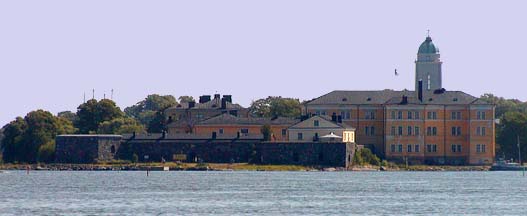 Although Helsinki was founded in 1550, it remained a sleepy town until 1748 when the Swedish State decided to construct an enormous fortress (Suomenlinna) off the coast to counter the growing threat from Russia. The manning of this fortress, along with the numerous builders, artisans and other professionals needed to complete the fortress helped to spark a period of growth for Helsinki. Part of the fortress is shown above and is open to the public. The islands appear to be a favorite day trip as the queues for the ferry were long.
Although Helsinki was founded in 1550, it remained a sleepy town until 1748 when the Swedish State decided to construct an enormous fortress (Suomenlinna) off the coast to counter the growing threat from Russia. The manning of this fortress, along with the numerous builders, artisans and other professionals needed to complete the fortress helped to spark a period of growth for Helsinki. Part of the fortress is shown above and is open to the public. The islands appear to be a favorite day trip as the queues for the ferry were long.
